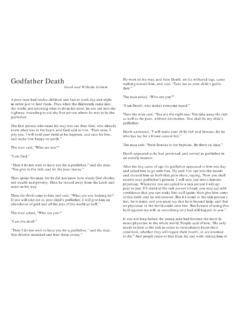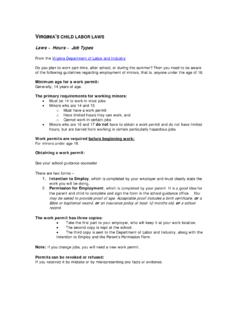Transcription of The Death of the Moth || Virginia Woolf
1 11 The Death of the moth || Virginia Woolf Moths that fl y by day are not properly to be called moths; they do not excite that pleasant sense of dark autumn nights and ivy-blossom which the commonest yellow-underwing asleep in the shadow of the curtain never fails to rouse in us. They are hybrid creatures, neither gay like butterfl ies nor sombre like their own species. Nevertheless, the present specimen, with his narrow hay-coloured wings, fringed with a tassel of the same colour, seemed to be content with life. It was a pleasant morn-ing, mid-September, mild, benignant, yet with a keener breath than that of summer months. The plough was already scoring the fi eld opposite the window, and where the share had been, the earth was pressed fl at and gleamed with These are the fi rst three sentences of Woolf s personal essay.
2 She is considered one of the most innovative writers of the last century. experimental style psychological concept applied to literature explores the defi nitions of reader and writing collective unconscious in print Paragraph one establishes the main character of the Death of the moth || Virginia Woolf Moths that fl y by day are not properly to be called moths; they do not excite that pleasant sense of dark autumn nights and ivy-blossom which the commonest yellow-underwing asleep in the shadow of the curtain never fails to rouse in us. They are hybrid creatures, neither gay like butterfl ies nor sombre like their own species.
3 Nevertheless, the present specimen, with his narrow hay-coloured wings, fringed with a tassel of the same colour, seemed to be content with life. It was a pleasant morn-ing, mid-September, mild, benignant, yet with a keener breath than that of summer months. The plough was already scoring the fi eld opposite the window, and where the share had been, the earth was pressed fl at and gleamed with It is important to fi rst note the title. It shows the Death of the moth , a specifi c insect within her environment, not just any moth in particular. Likewise, this opening series of sentences establishes three types of writing patterns: fi rst three sentences use both the Defi nition and the Description patterns fourth sentence begins a personal Narration, establishing a specifi c time, a moment in her life likewise these sentence establish mood and tone in order to display her under-current theme The statement seemed to be content with life shows a hints with foreshadowing for the closure of the piece.
4 Such vigour came rolling in from the fi elds and the down beyond that it was diffi cult to keep the eyes strictly turned upon the book. The rooks too were keeping one of their annual festivities; soaring round the tree tops until it looked as if a vast net with thousands of black knots in it had been cast up into the air, which, after a few moments sank slowly down upon the trees until every twig seemed to have a knot at the end of it. Then, suddenly, the net would be thrown into the air again in a wider circle this time, with the utmost clamour and vociferation, as though to be thrown into the air and settle slowly down upon the tree tops were a tremendously exciting experience.
5 The thesis is broken up and carried throughout the entire essay in small chunks, in progressive segments/installments. Throughout the demo, text highlighted in blue will show the crucial developing statements which combine into Woolf over-all thesis. This experimental approach is diffi cult to mimic. Thesis: Woolf s main purpose is to show: that the moth s actions embody our own actions. Nature is The same energy which inspired the rooks, the ploughmen, the horses , and even, it seemed, the lean bare-backed downs, sent the moth fl uttering from side to side of his square of the window-pane. One could not help watching him. One was, indeed, conscious of a queer feeling of pity for him.
6 The possibilities of pleasure seemed that morning so enor-mous and so various that to have only a moth s part in life, and a day moth s at that, appeared a hard fate, and his zest in enjoying his meagre opportunities to the full, pathetic. He fl ew vigorously to one corner of his compartment, and, after waiting there a second, fl ew across to the other. What remained for him but to fl y to a third corner and then to a fourth? That was all he could do, in spite of the size of the downs, the width of the sky, the far-off smoke of houses, and the romantic voice, now and then, of a steamer out at sea. What he could do he did. Watching him, it seemed as if a fi bre, very thin but pure, of the enormous energy of the world had been thrust into his frail and diminutive body.
7 As often as he crossed the pane, I could fancy that a thread of vital light became visible. He was little or nothing but life. Although the piece is largely descriptive, the narrative pattern takes control in the piece: One could not help watching him. Woolf contrasts the small insect against the immense sky to emphasize his frailty. and she continues the theme of the life-force found in nature. 53 Yet, because he was so small, and so simple a form of the energy that was rolling in at the open window and driving its way through so many narrow and intricate corridors in my own brain and in those of other hu-man beings, there was something marvellous as well as pathetic about him.
8 It was as if someone had taken a tiny bead of pure life and decking it as lightly as possible with down and feathers, had set it dancing and zig-zagging to show us the true nature of life. Thus displayed one could not get over the strangeness of it. One is apt to forget all about life, seeing it humped and bossed and garnished and cumbered so that it has to move with the greatest circumspection and dignity. Again, the thought of all that life might have been had he been born in any other shape caused one to view his simple activities with a kind pity. Theme of life-force continues. Throughout the piece she switches between personal narratives and narratives of the moth s struggle with Death ; a contrasting action in itself.
9 Relating back to herself adds emphasis of the moth s size contrasted to her own, yet both contain the same energy. The moth is personifi ed as a he in order to establish a common bond; the reader can relate better to the insect s plight visualizing him with human After a time, tired by his dancing apparently, he settled on the win-dow ledge in the sun, and, the queer spectacle being at an end, I forgot about him. Then, looking up, my eye was caught by him. He was trying to resume his dancing, but seemed either so stiff or so awkward that he could only fl utter to the bottom of the window-pane; and when he tried to fl y across it he failed. Being intent on other matters I watched these futile attempts for a time without thinking, unconsciously waiting for him to resume his fl ight, as one waits for a machine, that has stopped momentarily, to start again without considering the reason of its failure.
10 After perhaps a seventh attempt he slipped from the wooden ledge and fell, fl uttering his wings, on to his back on the window sill. The helpless-ness of his attitude roused me. It fl ashed upon me that he was in diffi cul-ties; he could no longer raise himself; his legs struggled vainly. But, as I stretched out a pencil, meaning to help him to right himself, it came over me that the failure and awkwardness were the approach of Death . I laid the pencil down again. Momentarily she forgets him for awhile until she realizes he is having difficulties; she considers helping but resists there is nothing she could do to help him. She begins to hint at the resolution for the story: struggle for life even in a small figure of an insect.









